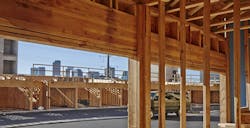Engineered wood helps meet booming demand for multifamily projects
The Glen at University Park, a complex of 107 three-story rowhouse condominiums for students at California State University’s San Bernardino campus, tells a story that is replaying in multifamily construction all over the country: The condos feature wood-frame construction that includes engineered wood products such as glulam beams and I-joists, a decision rooted in both value and performance.
For example, project engineer Amir Deihimi, PE, president of Core Structure, found that switching to glulam for structural beams in the floor and roof saved 20 to 30 percent over alternative framing options. “I had been under the impression that glulam was always custom and had a long lead time,” Deihimi says. “But the manufacturer had standard sizes and I-joist-compatible depths stocked at the lumberyard; there was no waiting for an order because it was all in stock.”
The ability to source products readily is an important factor in enabling architects, builders, and developers to quickly respond to the high demand for rentals with multistory wood-frame structures.
The Multifamily Boom
Single-family homeownership is a long-held American dream, but in the post-recession housing market, that dream has been put on hold for many. As a result, an increasing number of potential first-time home buyers are instead opting to rent, creating a demand for more apartment properties.
Besides the influence of those delaying their first home purchase, other drivers include a growing number of senior citizens who are downsizing. Added up, these factors are instigating a new boom in multifamily construction.
Multifamily housing starts reached 358,000 in 2014, a 16 percent increase over 2013 and the highest total since 2007, according to the U.S. Census Bureau. In the first half of this year, multifamily starts have averaged an annualized rate of 388,000 units, up 13 percent from the first half of 2014.
“We’re seeing greater availability of investment money for apartment construction,” says Joe Elling, market research director for APA – The Engineered Wood Association. “Lenders are easing standards for multifamily, and investors are realizing a 10-percent-per-year rate of return on rental properties—or more, depending on the region.”
The most recent Multifamily Production Index (MPI) released by the NAHB in May remained over 50 for the 13th consecutive quarter. “The steady performance of the MPI reflects the stable production rate we’ve seen recently in apartments and condos,” said NAHB Chief Economist David Crowe. “In terms of vacancies, the [Multifamily Vacancy Index] is the lowest it’s been in the last couple of years. As more renters enter the market after having put off forming their own households for an extended period, demand for multifamily housing continues to strengthen.”
Innovative Approaches to Multifamily With Wood-Frame Systems
Much of today’s multifamily construction blends familiar structural wood products and construction assemblies with new and updated products that add value and efficiency to the design and build process.
In many cities throughout the U.S., typical multifamily housing is composed of three- and four- story structures that incorporate many of the wood-frame products and techniques found in traditional single-family home construction. In some cases, innovative approaches to multistory design are also being applied. In particular, wood framing systems increasingly play a key role in meeting design and engineering goals.
Structural frames with engineered wood products offer a lightweight, strong, waste-reducing solution to even the most complex multifamily structural designs. There are several engineered wood floor systems that meet the one-hour fire-resistance requirements of multifamily structures. OSB and plywood sheathing also feature prominently as an affordable, durable option for floor, wall, and roof sheathing. Multifamily designers are also turning to the unlimited design flexibility of glulam, which boasts greater strength and stiffness than dimension lumber and easily accommodates long spans. Glulam beams are available in local markets in widths that match standard 2x4 and 2x6 wall construction, in I-joist-compatible depths, and in commonly used dimensions.
Glulam’s span capabilities were instrumental for the Winfield Gate rowhouse project in Houston, which consists of 22 four-story luxury townhomes. “There’s no question that the glulam helped us achieve our design goals,” says Andy Suman, partner at developer and builder Röhe & Wright. He noted that the glulam was able to span each unit from wall to wall, eliminating the need for interior load-bearing walls and therefore preserving open floor plans and flexible layouts.
At Westend in Denver, an urban garden-style apartment complex, glulam played a key role in a different design challenge: creating the cantilevers and bumpouts that were essential to the varied exterior façade. “Nobody wants a plain box anymore,” says Leo Brown, vice president of Carmel Partners and CP Construction. “The more ins and outs there are, the happier renters are, but the harder it is to frame. The glulam beams helped us meet those needs.”
The use of glulam beams elsewhere in that project, including headers over windows, doors, and garage doors, also brought monetary savings over alternative options. The beams’ 3-1/2-inch and 5-1/2-inch widths matched stud dimensions; alternative options would have required tripling up—and therefore additional money and labor. “With this large of a project, you really start to realize labor savings; it really gets multiplied across the project,” says Eric Hanson, PE, SE, president of Anchor Engineering.
Increasingly viewed as a system rather than a sum of parts, wood framing for multifamily is stretching to new heights, as well. In mid-rise mixed-use construction, architects are replacing the typical concrete “podium” (two to five stories of wood framing over a concrete, nonresidential first story) with a wood podium. Using a wood podium offers two key benefits: first, a wood podium reduces overall construction costs and time, and second, an all-wood podium results in a more sustainable, less massive building. For example, at the Galt Place affordable senior housing complex in Galt, California, designers estimate they saved more than $1 million by converting to a wood podium. Savings were realized through lower material costs, combined with soft-cost savings from faster construction, easier handling, and fewer trades on site. The Galt project employed gypcrete topping over wood structural panels supported by I-joists and glulam.
And the possibilities don’t end there. Architects in British Columbia are now code-permitted to design multifamily properties with wood framing up to six stories tall, a trend that could spread to the U.S. as familiarity increases. Elsewhere in the world, the use of cross-laminated timber has led to wood-framed apartment buildings as high as 10 stories.
“As multifamily continues to dominate the construction landscape, wood framing is an increasingly critical, reliable structural solution,” says Tom Kositzky, Field Services Director for APA. “In project after project, we’re witnessing how engineered wood products, from structural panels to I-joists to glulam, are helping architects reach new heights and solve critical design challenges affordably and efficiently.”

